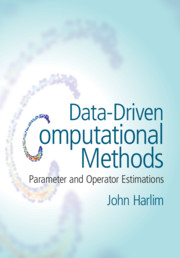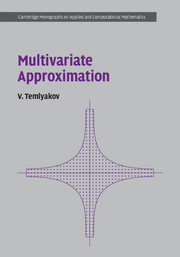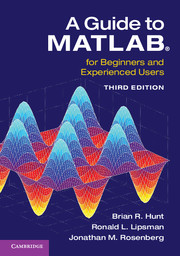Refine search
Actions for selected content:
2540 results in Computational Science
Index
-
- Book:
- Data-Driven Computational Methods
- Published online:
- 06 July 2018
- Print publication:
- 12 July 2018, pp 157-158
-
- Chapter
- Export citation

Data-Driven Computational Methods
- Parameter and Operator Estimations
-
- Published online:
- 06 July 2018
- Print publication:
- 12 July 2018

Multivariate Approximation
-
- Published online:
- 06 July 2018
- Print publication:
- 19 July 2018

A Guide to MATLAB®
- For Beginners and Experienced Users
-
- Published online:
- 28 May 2018
- Print publication:
- 21 August 2014
-
- Textbook
- Export citation
On the zeros of Dirichlet
 $L$ -functions – RETRACTION
$L$ -functions – RETRACTION
-
- Journal:
- LMS Journal of Computation and Mathematics / Volume 20 / Issue 1 / 2017
- Published online by Cambridge University Press:
- 10 May 2018, p. 53
-
- Article
-
- You have access
- Export citation
On the zeros of Dirichlet
 $L$ -functions
$L$ -functions
- Part of
-
- Journal:
- LMS Journal of Computation and Mathematics / Volume 14 / 2011
- Published online by Cambridge University Press:
- 01 May 2018, pp. 140-154
-
- Article
-
- You have access
- Export citation
Frontmatter
-
- Book:
- Mathematical Modelling and Simulation in Chemical Engineering
- Published online:
- 23 October 2018
- Print publication:
- 06 December 2017, pp i-iv
-
- Chapter
- Export citation
3 - Model Development for Complex Systems
-
- Book:
- Mathematical Modelling and Simulation in Chemical Engineering
- Published online:
- 23 October 2018
- Print publication:
- 06 December 2017, pp 31-56
-
- Chapter
- Export citation
Index
-
- Book:
- Mathematical Modelling and Simulation in Chemical Engineering
- Published online:
- 23 October 2018
- Print publication:
- 06 December 2017, pp 243-246
-
- Chapter
- Export citation
Contents
-
- Book:
- Mathematical Modelling and Simulation in Chemical Engineering
- Published online:
- 23 October 2018
- Print publication:
- 06 December 2017, pp v-x
-
- Chapter
- Export citation
Tables
-
- Book:
- Mathematical Modelling and Simulation in Chemical Engineering
- Published online:
- 23 October 2018
- Print publication:
- 06 December 2017, pp xv-xvi
-
- Chapter
- Export citation
Figures
-
- Book:
- Mathematical Modelling and Simulation in Chemical Engineering
- Published online:
- 23 October 2018
- Print publication:
- 06 December 2017, pp xi-xiv
-
- Chapter
- Export citation
10 - Simulation Using Matlab/Scilab
-
- Book:
- Mathematical Modelling and Simulation in Chemical Engineering
- Published online:
- 23 October 2018
- Print publication:
- 06 December 2017, pp 187-214
-
- Chapter
- Export citation
4 - Analytical Solutions of Model Equations
-
- Book:
- Mathematical Modelling and Simulation in Chemical Engineering
- Published online:
- 23 October 2018
- Print publication:
- 06 December 2017, pp 57-74
-
- Chapter
- Export citation
11 - Model Based Control
-
- Book:
- Mathematical Modelling and Simulation in Chemical Engineering
- Published online:
- 23 October 2018
- Print publication:
- 06 December 2017, pp 215-234
-
- Chapter
- Export citation
Preface
-
- Book:
- Mathematical Modelling and Simulation in Chemical Engineering
- Published online:
- 23 October 2018
- Print publication:
- 06 December 2017, pp xvii-xviii
-
- Chapter
- Export citation
6 - Modelling and Simulation: Case Studies
-
- Book:
- Mathematical Modelling and Simulation in Chemical Engineering
- Published online:
- 23 October 2018
- Print publication:
- 06 December 2017, pp 93-120
-
- Chapter
- Export citation
8 - Sensitivity Analysis
-
- Book:
- Mathematical Modelling and Simulation in Chemical Engineering
- Published online:
- 23 October 2018
- Print publication:
- 06 December 2017, pp 135-151
-
- Chapter
- Export citation
2 - Model Development for Simple Systems
-
- Book:
- Mathematical Modelling and Simulation in Chemical Engineering
- Published online:
- 23 October 2018
- Print publication:
- 06 December 2017, pp 11-30
-
- Chapter
- Export citation
5 - Numerical Solutions of Model Equations
-
- Book:
- Mathematical Modelling and Simulation in Chemical Engineering
- Published online:
- 23 October 2018
- Print publication:
- 06 December 2017, pp 75-92
-
- Chapter
- Export citation



